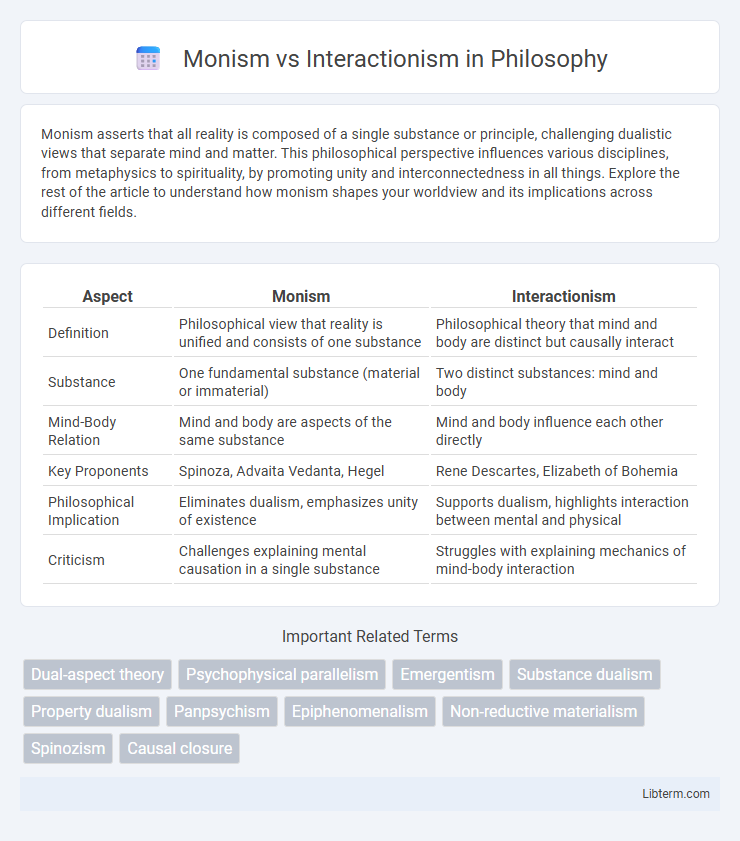Monism asserts that all reality is composed of a single substance or principle, challenging dualistic views that separate mind and matter. This philosophical perspective influences various disciplines, from metaphysics to spirituality, by promoting unity and interconnectedness in all things. Explore the rest of the article to understand how monism shapes your worldview and its implications across different fields.
Table of Comparison
| Aspect | Monism | Interactionism |
|---|---|---|
| Definition | Philosophical view that reality is unified and consists of one substance | Philosophical theory that mind and body are distinct but causally interact |
| Substance | One fundamental substance (material or immaterial) | Two distinct substances: mind and body |
| Mind-Body Relation | Mind and body are aspects of the same substance | Mind and body influence each other directly |
| Key Proponents | Spinoza, Advaita Vedanta, Hegel | Rene Descartes, Elizabeth of Bohemia |
| Philosophical Implication | Eliminates dualism, emphasizes unity of existence | Supports dualism, highlights interaction between mental and physical |
| Criticism | Challenges explaining mental causation in a single substance | Struggles with explaining mechanics of mind-body interaction |
Introduction to Monism and Interactionism
Monism asserts that reality is unified and composed of a single substance, either mental (idealism) or physical (materialism), emphasizing the oneness of existence. Interactionism posits that mind and body are distinct entities that causally influence each other, maintaining dualistic perspectives on consciousness and physical processes. Key philosophical figures include Spinoza for monism and Descartes for interactionism, highlighting foundational debates on the nature of mind-body relationship.
Defining Monism: Philosophical Foundations
Monism posits that reality is fundamentally composed of a single substance or principle, either material or immaterial, underpinning all existence. This philosophical foundation is often associated with figures like Spinoza, who argued for a unified substance, and later idealists who emphasized mental unity. Defining Monism involves understanding the ontological commitment to one kind of substance, contrasting sharply with Interactionism's dualistic approach that asserts a distinct separation between mind and body.
Explaining Interactionism: Core Concepts
Interactionism asserts that mind and body are distinct entities that causally influence each other, emphasizing a two-way relationship between mental states and physical processes. This dualistic perspective highlights how decisions, intentions, and consciousness can affect neurological activity, while brain states also impact thoughts and emotions. Key proponents like Rene Descartes argued for this bidirectional interaction to explain phenomena like voluntary physical actions driven by mental intentions.
Historical Perspectives: Evolution of Both Theories
Monism, rooted in ancient philosophies such as those of Parmenides and Spinoza, proposes a singular substance or reality underlying all existence, while Interactionism emerged prominently in the 17th century through Rene Descartes' dualist framework distinguishing mind and body as separate entities. The historical development of Monism advanced through materialist and idealist interpretations, influencing modern physicalism and pantheism, whereas Interactionism confronted challenges related to causal interaction between distinct substances. Debates during the Enlightenment and subsequent advancements in neuroscience and philosophy of mind have continuously shaped the evolution of both theories, highlighting diverse approaches to understanding consciousness and reality.
Key Differences Between Monism and Interactionism
Monism asserts that mind and body are unified as a single substance, either physical or mental, whereas Interactionism holds that mind and body are distinct entities that causally influence each other. Monism emphasizes a non-dualistic ontology, often identifying mental states as brain states, while Interactionism supports dualism, proposing a bidirectional relationship between mental and physical substances. The key difference lies in monism's rejection of separate substances, contrasting with interactionism's commitment to two interacting but fundamentally different realms.
Monism in Contemporary Philosophical Debate
Monism in contemporary philosophical debate emphasizes the view that reality is fundamentally composed of a single substance or essence, typically categorized as either physical (materialism) or mental (idealism). This position challenges interactionism by rejecting dualistic frameworks that separate mind and body into distinct ontological entities, instead proposing unified explanations for consciousness and physical phenomena. Current advancements in neuroscience and quantum physics increasingly support monistic interpretations, reinforcing arguments that mental states are emergent properties of physical processes rather than independent substances.
Interactionism: Modern Interpretations and Applications
Interactionism, a dualist theory in philosophy of mind, posits that the mind and body are distinct substances that causally interact, influencing each other's states. Modern interpretations emphasize neurobiological evidence supporting bidirectional communication between mental states and brain processes, integrating psychological experiences with physical mechanisms. Applications of interactionism are evident in cognitive science and psychotherapy, where mental intentions can alter neural activity and physical health, demonstrating mind-body interdependence.
Scientific Implications: Neuroscience and Mind-Body Problem
Monism posits a unified substance or reality, suggesting that mental states arise directly from physical brain processes, thus aligning with neuroscience findings on neural correlates of consciousness. Interactionism argues for a two-way causal relationship between mind and body, challenging purely physicalist models by emphasizing non-physical mental causation, yet complicating empirical measurement in neuroscience. These contrasting views critically influence interpretations of brain function, consciousness studies, and the development of integrative models addressing the mind-body problem in cognitive science.
Criticisms and Challenges for Both Approaches
Monism faces criticism for oversimplifying the complexity of consciousness by reducing mental states to a single substance, often struggling to explain subjective experiences and the mind-body problem comprehensively. Interactionism, which posits a bidirectional causal relationship between mind and body, encounters challenges in explaining how non-physical mind substances can influence the physical brain without violating physical laws or causal closure. Both approaches grapple with scientific validation, as monism often lacks empirical evidence for its unified substance claim, while interactionism risks dualistic implications that complicate integration with neuroscience.
Future Directions in Mind-Body Philosophy
Exploring future directions in mind-body philosophy involves advancing integrative frameworks beyond traditional monism and interactionism, emphasizing neurophenomenology and embodied cognition to bridge subjective experience with neural processes. Cutting-edge research leverages quantum models and dynamic systems theory to elucidate causal relationships between mental states and physical substrates. Emerging interdisciplinary approaches aim to dissolve classical dichotomies, fostering holistic paradigms that unify consciousness studies with neuroscientific discoveries.
Monism Infographic

 libterm.com
libterm.com